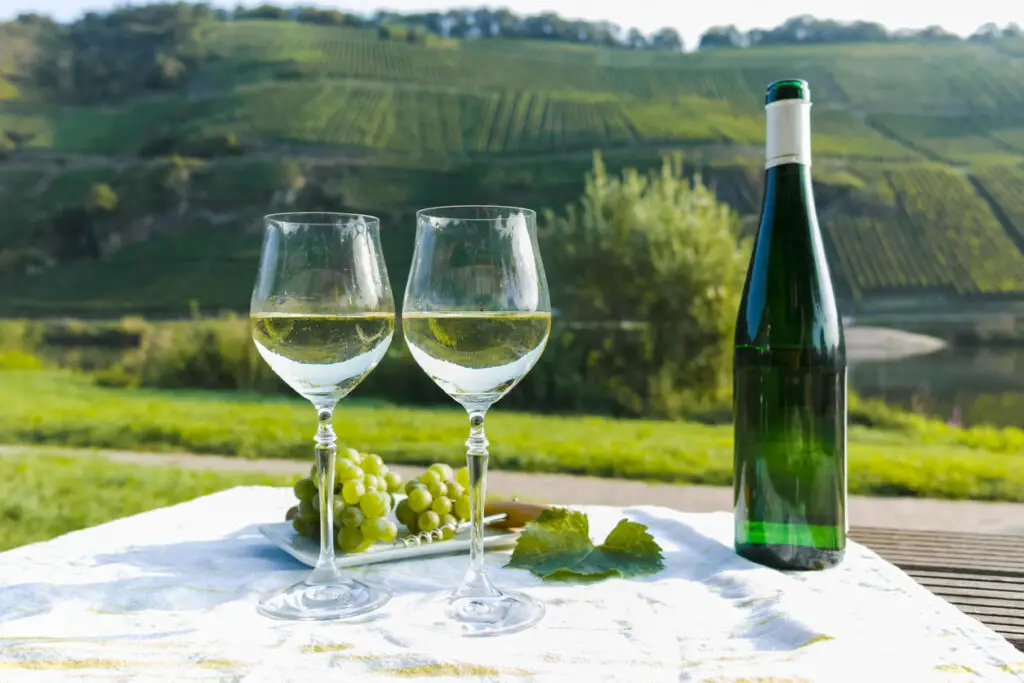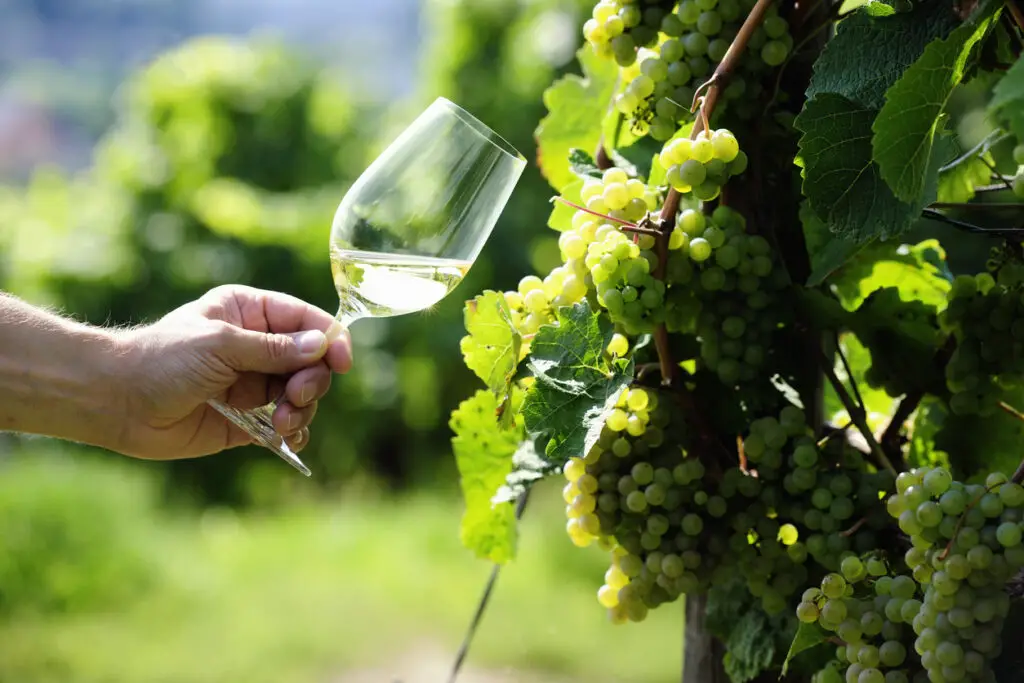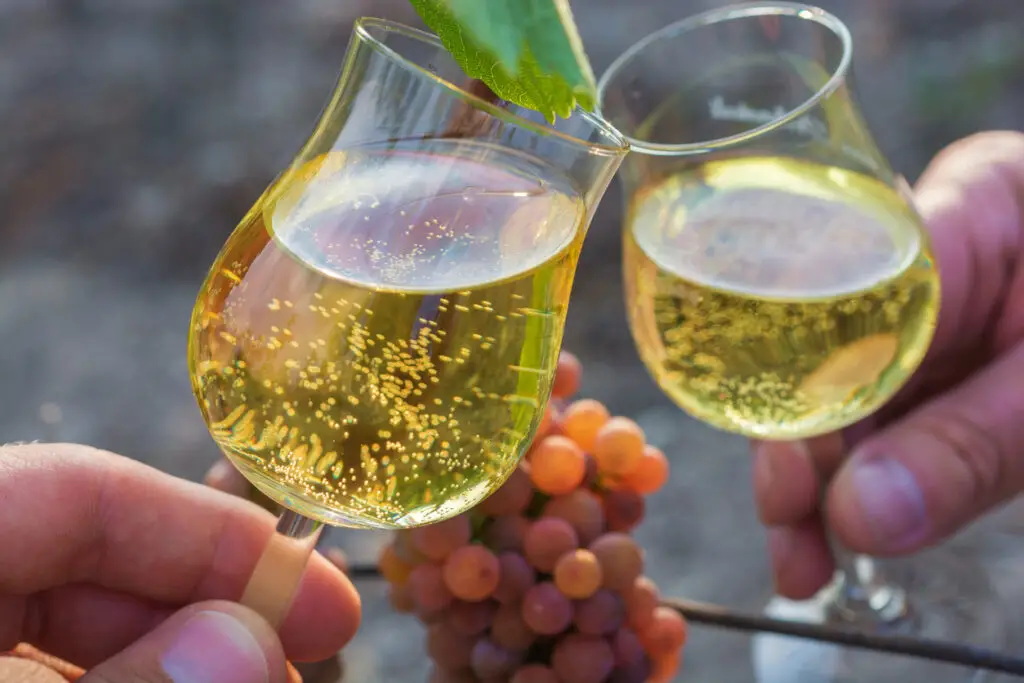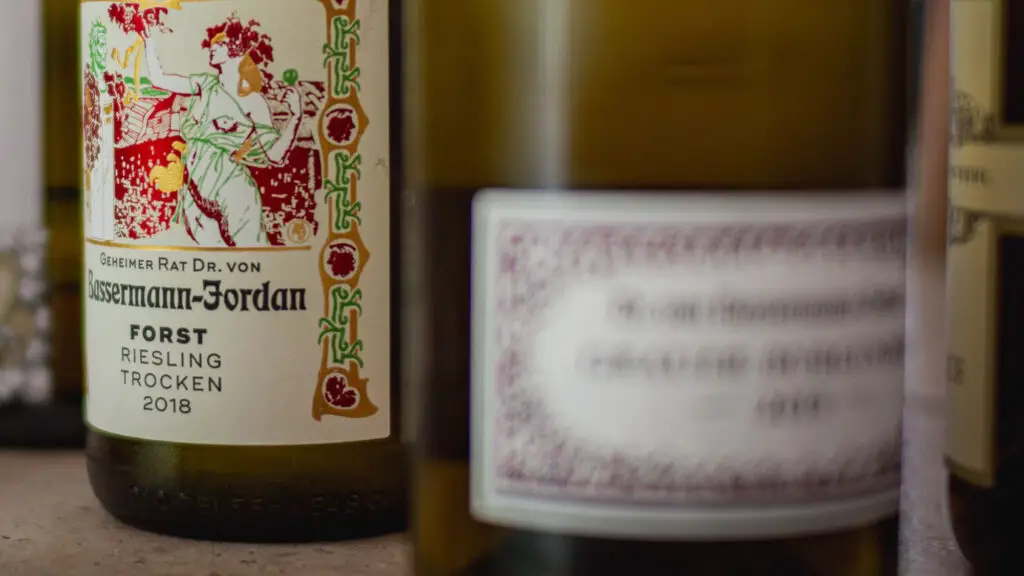You’ve started experimenting with new wines and are gazing at the white wine cooler at your local grocery store. While you may be familiar with Riesling, you wonder what the seemingly German bottle is sitting next to it. To wine newbies, Gewürztraminer and Riesling are difficult to differentiate between. They both come in tall slender shaped wine bottles that are shaped differently than many other wines. So what’s the difference between Gewürztraminer vs Riesling?
Gewürztraminer has higher alcohol and a more robust mouthfeel while Riesling is more crips due to its higher acidity. Riesling is also grown more widely around the world than Gewürztraminer. Due to its popularity and greater production, it is usually easier to find.
There are key characteristics that will help you identify which one you might prefer to take home. These wines are a good alternative if you find Pinot Grigio overly tart. They are both aromatic white wines that can be from the same wine region. They are bold wines that pack a strongly unique punch.
Let’s learn more about the differences between Gewürztraminer vs Riesling.
Aromatic Wine
White wines are often classified as light-bodied, full-bodied, and aromatic. This refers to the wine’s most notable characteristics and intensity on the palate. Aromatic wines are categorized by the actual grape profile.
Author Note: Many styles of wine fall into their category due to the characteristics they pick up during the winemaking process. Think about a full-bodied cabernet sauvignon with a lot of tannin texture. The oak barrels used will impart additional tannin texture and body.
Another example is Chardonnay, which is not aromatic. When you smell butter or toasty vanilla you are taking in elements that are added during the winemaking process like malolactic fermentation and aging in oak barrels. These are not aromatics from the grape itself.
Gewürztraminer and Riesling are considered aromatic wines. This style of wine will have very strong perfumed characteristics that are derived from the grape. Some rieslings even smell like petrol!
Albarino, Moscato, and Torrontes are examples of other aromatic white wines.
These wines are unique because they have more concentration of terpenes, a compound class also found in flowers.
Gewürztraminer vs Riesling: How Can You Tell Which is in Your Glass?

If you pour a glass of Riesling you will notice it may have a pale greenish straw-like color. It can range from pale to a rich yellow hue. Gewürztraminer on the other hand tends to be a darker yellow to deep golden color.
Riesling’s crisper aromatics tend to offer hints of citrus fruit and fresh floral notes. Bright aromas like lemon, cherry blossom, peach, and ripe apple will fill your nose when you drink Riesling. You may find a bit more minerality than you would in Gewürztraminer.
Gewürztraminer has strong exotic fruit and sweet spice aromas. You may find tropical fruit like lychee, mango, apricot, or pineapple. Its spicy (like backing spice, not hot chili peppers) notes may remind you of ginger, caramel, cinnamon, or allspice.
The “mouth feel” of these wines differ as well. Riesling’s high acidity will make it feel more like drinking lemonade. It will have intense flavor but will come across lighter and brighter.
With higher alcohol content, Gewürztraminer has a richer silky or oily texture. It can have a similar texture to syrup, though it is not always sweet. You may find elements of honey from noble rot.
These wines can range from bone dry to intensely sweet. They are occasionally blended with other grape varietals or made into sparkling wine.
Gewürztraminer vs Riesling: How Sweet is It?
While these wines are often described as sweet, you may be surprised to find that they both have styles that range from dry to sweet.
Moscato is typically the sweetest wine in the aromatic category. Many producers list sweetness on the front or back of the wine label.
Riesling grapes are naturally highly acidic so traditionally they have been made sweet to balance the acid. Yet, winemakers have begun to alter the amount of residual sugar left in the bottle. You can find fantastic styles of Riesling that are bone dry with a bouquet of crisp aromas. The Moselland Cat Riesling is a prime example.
Top Tip: The German wine classification system labels it’s Rieslings by quality and sweetness level. From sweetest to driest it can be labeled Trocken, Auslese, Spatlese, Kabinett, Halbtroken, Fenherb, and Troken. Although, you may see some simply labeled “dry” or “sweet”.
Most Gewurztraminer will be off-dry, meaning a hint of sweetness. However, it often tastes sweeter than it actually is because of its high alcohol, low acidity, and strong aromatic properties. Some have sweet-smelling aromas but taste dry on the palate.
Gewürztraminer vs Riesling: Origins and Growing Regions
Riesling originated in the Rhine region and has grown in production ever since.
As you may have noticed that Riesling is more widely available and popular. There is almost four times more Riesling produced worldwide than Gewürztraminer.
Germany is known to produce the best Rieslings in the world. They are produced in a range of sweetness styles. Austria is known to produce high-quality Riesling in decent quantities. This bold wine can also be found in the United States, Australia, and France.
Gewürz means “spice” in German with roots in German-speaking northern Italy. Do not confuse the term spicy to mean hot like a chili pepper. It has characteristics that you find in warm baking spices.
While both Riesling and Gewürztraminer can be found in Alsace, it produces the most Gewürztraminer in the world.
Noble grape varieties of Alsace include Gewürztraminer, Reisling, Pinot Gris, and Muscat. A fifth grape variety, pinot blanc, is also very commonly grown here.
Regions such as Trento, Italy; Alsace, France; and Monterey, California produce Dry to off-dry Gewürztraminer.
Dry versions from Alsace will have a little salinity and an oily texture. Alsace is also well known for producing high-quality dessert wines.
Gewürztraminer vs Riesling: In the Vineyard

Both Gewürztraminer and Riesling grapes strongly reflect the terroir. They like to take on characteristics from the soil and climate and incorporate them into their flavor and aroma profile. This contributes to their superb aromatic qualities.
Gewürztraminer and Riesling ripen earlier than many other well-known varietals. This means they do best in a cooler climate. In a warm climate, they will ripen too quickly and become overripe and flabby.
Gewürztraminer is a temperamental grape variety that somewhat difficult to grow. It grows best in cool climates like the areas surrounding the alps.
Gewürztraminer must be harvested at peak ripeness to retain fruitiness as the grape doesn’t have much acidity. This will keep the wine from becoming unbalanced with towering alcohol and over the top sweetness.
Author Note: Riesling is a white/greenish grape that is used to make white wine. It may surprise you that Gewürztraminer is actually a pink grape that is used to make white wine. Don’t let this confuse you with the red or black grapes used to make red wine.
The winemaking process for all aromatic wine is usually similar. Grapes are harvested and destemmed then immediately put through a press to separate the juice from the skin and seeds.
The juice is fermented in stainless steel tanks to retain the grapes’ bright aromas. This is often done at cooler temperatures to speed up the fermentation process.
Fermentation is likely stopped before all the sugar has been processed out and allowed to settle at cooler temperatures for a short period. From there the wine is clarified and bottled.
This style of wine doesn’t usually require aging so it will be released for sale shortly thereafter.
Gewürztraminer vs Riesling: How to Serve?
Because of Rieslings’ high acidity, it can improve with age. You can hold on to a bottle for up to 10 years.
Gewürztraminer is best enjoyed young, within a year or two of release. This will allow the wine’s peak acidity to balance its rich sweeter characteristics.
Both wines are best served cold, right out of the refrigerator, around 43 degrees Fahrenheit. Never decant or aerate these wines. You will loose precious flavors.
If you are on the search for value wines, look for Gewürztraminer. You can find many great bottles under $20. More flavor for your dollar.
Most high-quality Rieslings will be around $20 to $40.
Gewürztraminer vs Riesling: Food Pairing

Gewürztraminer’s sweet baking spice and dried fruit aromas make a tremendous match for including these ingredients like Moroccan food.
Dryer Gewürztraminer pairs nicely with spicy Asian food. Choose cheeses like Munster and gouda for a nice appetizer pairing.
Sweet styles of both of these wines go well with a dessert that has flavors of cinnamon and dried fruit. Opt for a fruit-topped cheesecake or a berry tart.
Riesling is a great pair of spicy food because of its acidity and sweetness. Try it with Thai green curry food or a hot Chinese dish. Indian is another fantastic option.
Conclusion
Gewürztraminer and Riesling both have a long-standing association with the cool climate regions around the Rhine river. Regions in Germany and France specialize in these wines while there a varying amount produced the world over.
Riesling is best known from Germany and Gewürztraminer is best known from Alsace, France. The amount of Riesling production greatly outweighs Gewürztraminer making it much easier to find in a store near you.
These wines are known for their robust aromatics derived from the grape rather than the winemaking process. Both wines can be found in styles that range from dry to sweet.
Riesling, brighter in color, is more acidic with citrus aromas. Gewürztraminer, more golden in color, has higher alcohol with dried fruit and baking spice flavors.
To living a full-bodied life,
Wesley

